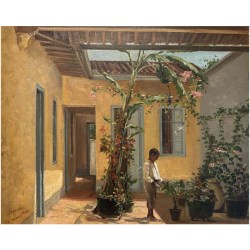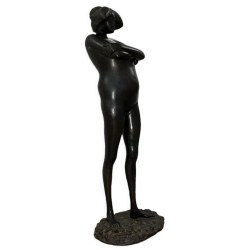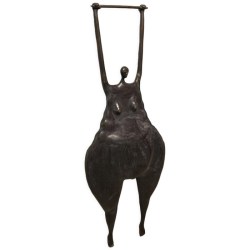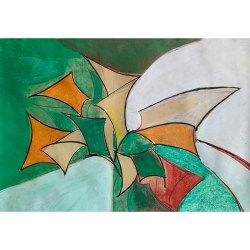Bio
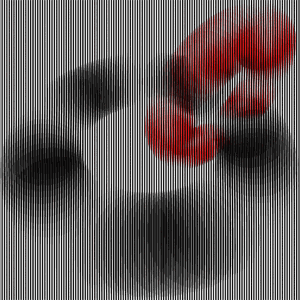 (Rafael Parra Toro. Caracas, 1977) is a Venezuelan/Argentinean artist and engineer whose production is characterized by the contemporary development of kinetic-optical art[2], based on the combination of character design aesthetics and the use of new digital technologies. His work deals with and explores the experiences of international optic kinetism[3] and combines them with the analysis of the viewer’s movement and color vibration through the use of moiré[4], chromatic interferences and mathematical and IT tools that are usually applied to digital art, in order to create a geometrical universe that is full of shapes and characters.
(Rafael Parra Toro. Caracas, 1977) is a Venezuelan/Argentinean artist and engineer whose production is characterized by the contemporary development of kinetic-optical art[2], based on the combination of character design aesthetics and the use of new digital technologies. His work deals with and explores the experiences of international optic kinetism[3] and combines them with the analysis of the viewer’s movement and color vibration through the use of moiré[4], chromatic interferences and mathematical and IT tools that are usually applied to digital art, in order to create a geometrical universe that is full of shapes and characters.
Unlike the traditional use of the moiré effect in international optical kinetism –in relation to which we can mention the Venezuelan artist Jesús Soto and the German artist Ludwig Wilding as pioneers in the exploration and use of this technique for artistic purposes- PARRATORO uses moiré to create shapes and volumes in his geometric universe. The artist draws using moiré, and thus poses a radical change in the used his predecessors made of it.
Regarding the technical resource of color, the chromatic interference concept follows the color research line started by Venezuelan artist Carlos Cruz-Diez[5]. The experimentation and search for colors are based on which of them are the best to favor the shape and volume the artist wishes to achieve by the use of moiré. Pure colors come from the plotter –black, yellow, cyan and magenta– as well as from the color of the material on which the printout is made, and a chromatic interference of parallel vinyl lines –also made of pure colors- is overlapped on them at a certain distance from the background image.
The artist said:
‘The source of my work is digital, and I am honest with this source. I work strictly with geometry and pure colors from a plotter, I am not trying to depict something real; what makes it real is the viewer presence through his/her optical perception. The viewer generates shapes and colors by moving along the space where my Works are located. Thus, I believe that my work is kinetic’.[6]
Years of Training and Experimentation
PARRATORO was born in Caracas, a city surrounded by mountains that may only be understood if you know and live in it. View, perception and movement are three principles that will appear in the production of many artists from this city, and PARRATORO is no exception. The concept of integrating art and nature is another important topic covered by Venezuelan kinetism and op artists in the 60’s, which may have shared the fact of living and growing up in a city surrounded by the vegetation’s green and the highways’ concrete grey.
The artist was raised in a country that gave him the opportunity to grow up watching the works by great international creators such as Victor Vasarely, Alexander Calder, Fernand Léger, Jean Arp, Antoine Pesvner, Henri Laurens, Sophie Taeuber, Joan Miró and by local artist such as Gego, Jesús Soto, Carlos Cruz Diez, Víctor Valera, Oswaldo Vigas, Harry Abend, Alejandro Otero, designer Gerd Leufert and architect Carlos Raúl Villanueva[7]. Many of these works are located in an urban space and integrated with the city sights. The visual and emotional impact of these works marked an experience that determined his future artistic development. The integration of art and landscape in an organic and geometric urban nature established the foundations of his plastic research, focused on the research and experimentation processes that drove his analysis.
PARRATORO claims to be a great admirer of Alexander Calder[8], with whom he shares the engineering education, the interest in the playful component, the interaction with the viewer and the subtle limit between abstraction and figure. Play, movement, experimentation with new materials and exploration of color and light have been present both in the Mobiles and the Circus of the American artist, and have proved critical for the searches performed by international kinetism.
Light, color and movement within an endless view spectrum have been a daily component in the artist’s life, and this factor was not overlooked during his University years. At the auditorium of Caracas University, under Calder’s Floating Clouds[9] , he got his Engineering degree. These studies, to which he has not devoted to in his professional life, taught him to love mathematics, the discipline and the work methodology that he has later applied to his work.
Curiosity and interest in experimentation drove his learning and elaboration of the world of new technologies until he became one of the pioneers in the development of 3D art in Latin America with the use of the tri-dimensional software tool called Alias Maya. Years later, he worked in the videogame industry as a 3D art developer for different international companies. Among his most important work, we can mention the development of MUSICTOONS[10], a company devoted to the creation of artistic assets for videogames, and the creation of games for Cartoon Network, Dreamworks and Nickelodeon.
This work period should be thought of as an experimentation stage which provided a great knowledge, and although PARRATORO considers that the final product of this industry generates a certain disconnection among people and promotes isolation from reality, we can see how part of his current aesthetics is rooted in these first research and works.
From the Universe of Videogames to Character Design
Three principles inherited from the animation industry’s Animated Character Design are critical to our artist’s production ̶ appeal, simplicity and clarity. Appeal is a complex defining principle. It is based on the empathy or attraction of characters perceived by the viewer thanks to his/her subjective point of view, personal opinion and visual taste. Simplicity, the simplicity of shapes, is a simple technique that is based on the use of basic shapes to draw attention from detail and focus it on shapes. Finally, clarity refers to a clean design aimed at preventing visual confusion, since a character design does not require a great deal of detail in order to be interesting.
In PARRATORO’s works, empathy (appeal) is generated in a ludic and creative environment based on the interaction with the viewer, who participates by feeling and experimenting as s/he moves along the room. It should be highlighted that the shapes and characters in his works are defined with the visitor’s movement. Here, it differs from the videogame and animation industry, since the characters are not figures established by the creator but depend on this active participation and intervention by the viewer.
In 1999 the German organization PICTOPLASMA[11] was founded, devoted to international character design art. Thanks to research and sharing activities, it has become a platform used to debate and redefine the boundaries of contemporary character representation within the international artist, creator and theorist community, driving a new understanding of the character throughout the world.
The main focus of this project is based on the empathic feature (appeal) principle for certain images in order to create direct emotional links with the viewer. The proposal is concrete, and is based on visual and conceptual search and exploration within character design to achieve a balance between empathy and symbol. A sort of intermediate point between Mickey Mouse and pictogram aesthetics[12], it communicates and takes the limits of the anthropomorphic representation appeal one step further worldwide.
The production of the graphic artist Akinori Oishi[13] falls within the topics covered by Pictoplasma. A product of illustration and typographic aesthetics, he has used color markers and paper as his privileged production tools. Synthesis dominates his work[14], based on a repetition idea focusing more on the process than on the result. A follower of the marker aesthetics, he has taken his characters to different supports and dimensions; he sometimes repeats them until full surfaces are covered, or depicts them as a single character on individual or small group portraits. By multiplying these beings, a particular dynamism is achieved. They are made of specific and concentrated elements –tiny lines and small dots. These are characters that generate empathy with the viewer from specific visual resources thanks to the briefness and simplicity of the story they tell.
Fascinated by the possibilities offered by character design, PARRATORO formed part of the first Pictoplasma Academy (2013), an intensive educational program dedicated to training and interchange in the character creation scenario. Together with some other artists, he created The eggplant collective[15], an art group where a topic is chosen every month with the main objective of exploring character representation.
In the artistic universe that emerges from the Berlin character design concept and materializes in the geometric purity of shapes and figures, color is a core element to the construction process and, as in the optic kinetism of the 60’s, light and viewer form a critical couple. Along this path, he started his artistic period and began researching into the principles that would later characterize his work.
An Approach to the Concept of Digital Kinoptics
New technologies have established a dynamic relation between art and the culture of each historical period. The Twenty First Century has brought us dramatic improvements in the IT area, and these technologies offer potentially unlimited possibilities to the creation of works of art. Digital Art is a wide concept that may simply involve the use of a computer at some point of the production process, whether the works are made on conventional material supports or are exhibited using electronic devices. So, what is specific to digital art?
In this paper, we consider as digital art any artistic two/tridimensional production conceived using a software during the production process, regardless of the support or format used for its exhibition.
Although PARRATORO’s production is marked by the experimental search for movement, color and shapes inherited from Venezuelan kinetism, talking about neo-kinetism does not appear to be relevant since what is present in his production results from combining a series of factors and aesthetics that exceed the ‘neo’ concept.
Our artist shares two basic qualities with contemporary kinetism: on the one hand, the loss of formalist purity, which means departing from the concrete art and the abstract geometry that inspired optic and kinetic artists in the 60’s, and on the other, this contemporary trend towards an aesthetics that mixes abstraction and figuration surpassing its boundaries.[16] Thus, a new term is suggested that matches the work under analysis: kinoptics.
The kinoptic art concept refers to the optic trend of contemporary kinetism where the transformation in the work body is achieved by the physical movement of the viewer through space. The specific feature of kinoptic art is based on the perception capacity of the receiver as a driver of the actual movement of the parts.[17]
PARRATORO’s images are conceived and produced using digital technology. The use of the computer both in the creative phase of the initial production and in the evolution of his projects is critical. Although the shapes created by the moiré effect and the colors resulting from chromatic inductions are present in the work once they are materialized in non-digital supports (wood, metal, PVC foam, Plexiglas, digital printing and vinyl), the possibility of trial and experimentation allowed by the software used is another important feature as a digital production entity.
PARRATORO depicts a world of movement that is animated by the viewer. Here, colors –that appear to be infinite- are obtained from chromatic interferences that come from a reduced range of multiple and dynamic colors and shapes, originated in the moiré effect. As an example, we can mention the works Moiréph #2 and Moiréph #6[18], which form part of the recent series MOIRÉPH (2015) produce by the artist.
Rafael Parra Toro (PARRATORO) is an experimental artist and engineer based in Buenos Aires who dedicates himself to digital kinoptic art. His work has been exhibited at Miami's Art Basel Circuit with Curator's Voice Gallery and Pictoplasma (Berlin). He is also author of The POP ON OP Book, funded via Kickstarter, as well as author of "Frenetic Kinetic" game for iOS and Android, and creative director of Kinetic brand.
Rafael’s work is highly influenced by an array of geometric shapes and exhibits a blend of black and white to bright and energetic color palettes. His style often consists of gestalt-driven shapes that create interesting character faces and patterns.
PARRATORO's art has been covered by various print and web publications like Inkygoodness, Creative Bloq, Creative Review,, Ridyn, We Choose Art, Garatujas Fantasticas, Design Taxi, STASH, Mitteschon Magazine and Fubiz.
He's currently represented in Miami by Curator's Voice Art Projects and has an artist's residency in "Distrito de las Artes", Buenos Aires, by Fundación Tres Pinos.


